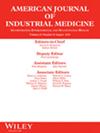Dermal Exposure to Agrochemicals as Risk Factor for Skin Cancer in Farmers and Ranchers in the US Central States
Abstract
Background
Farm operators are at a high risk of developing skin cancer due to their occupational sun exposure. With the growing incidence of skin cancer, it is also important to evaluate other occupational risk factors. Farm operators confront numerous physical, chemical, and biological hazards in their work environment. This study investigated whether dermal exposures to pesticides/fertilizers, animals/livestock, detergents/disinfectants, and fuels/solvents/paints were associated with the risk of skin cancer in farm and ranch operators.
Methods
Surveillance data from the Central States Center for Agricultural Safety and Health (CS-CASH) Farm and Ranch Health and Safety Surveys in 2018 and 2020 were used to explore the risk of skin cancer in farm operators in seven US central states. Farm production variables from the DTN Farm Market database were merged with survey responses. The associations of skin cancer and exposure variables were analyzed using descriptive statistics and regression modeling.
Results
The prevalence of skin cancer was 10% among 7943 operators. Univariable analyses showed that men had 1.62 times higher odds of skin cancer compared to women. The odds of skin cancer increased significantly with age. Livestock, fed cattle, cow-calf, and beef production increased the odds of skin cancer. Exposure to pesticides/fertilizers and fuels/solvents/paints also increased the odds of skin cancer compared to unexposed operators. In the final multivariable model, the associations of skin exposure to pesticides/fertilizers (odds ratio (OR) = 1.30, 95% CI: 1.08–1.56) and to fuels/solvents/paints (OR = 1.21, 95% CI: 1.01–1.45) remained statistically significant after adjusting for sex, age, and state. Having livestock also increased the odds of skin cancer (OR = 1.18, 95% CI: 1.00–1.38).
Conclusion
Skin is a critical source of occupational exposures among farm operators. Increased odds of skin cancer in this study emphasizes the need for better protection against exposures to chemicals including pesticides/fertilizers, and fuels/solvents/paints.


 求助内容:
求助内容: 应助结果提醒方式:
应助结果提醒方式:


